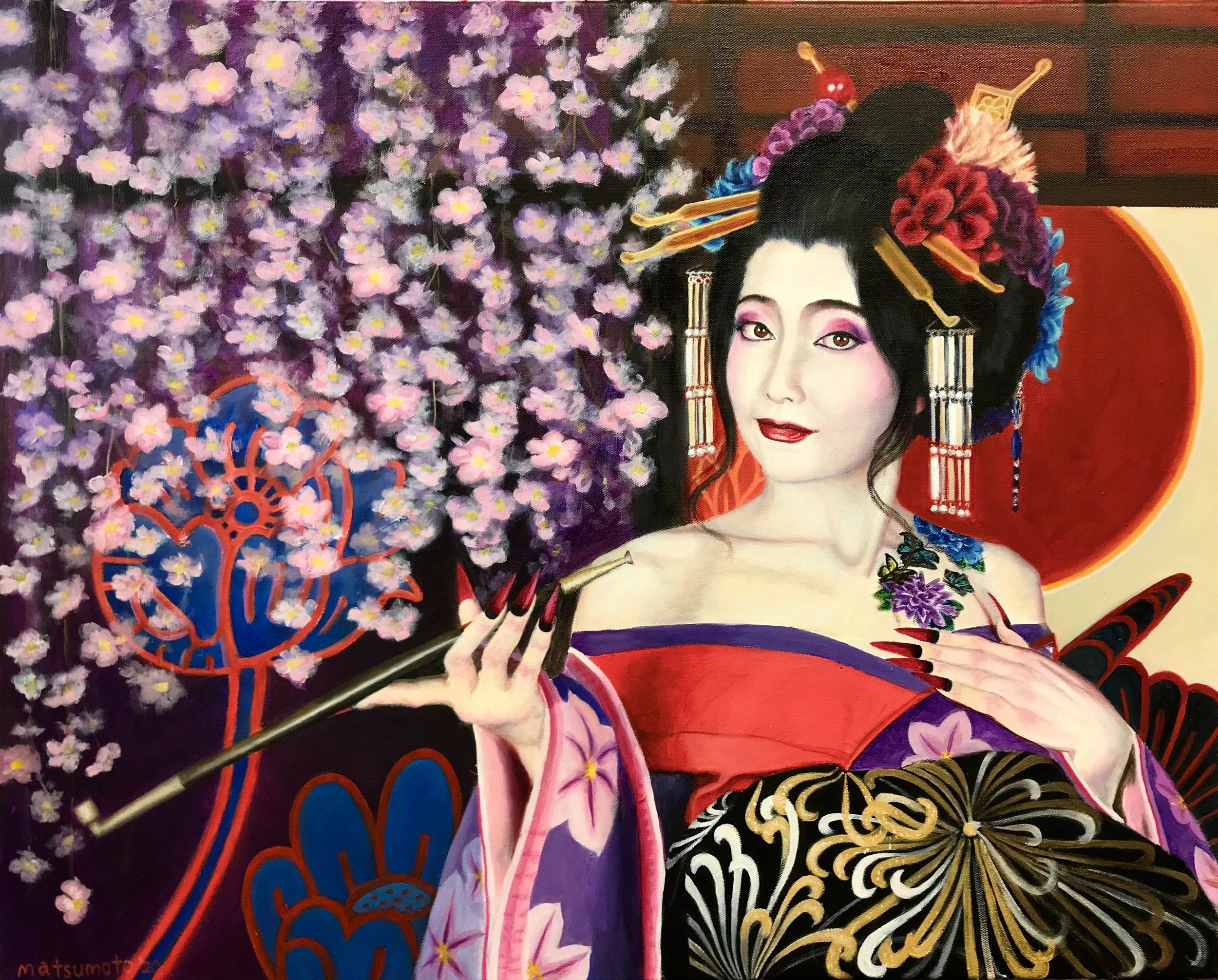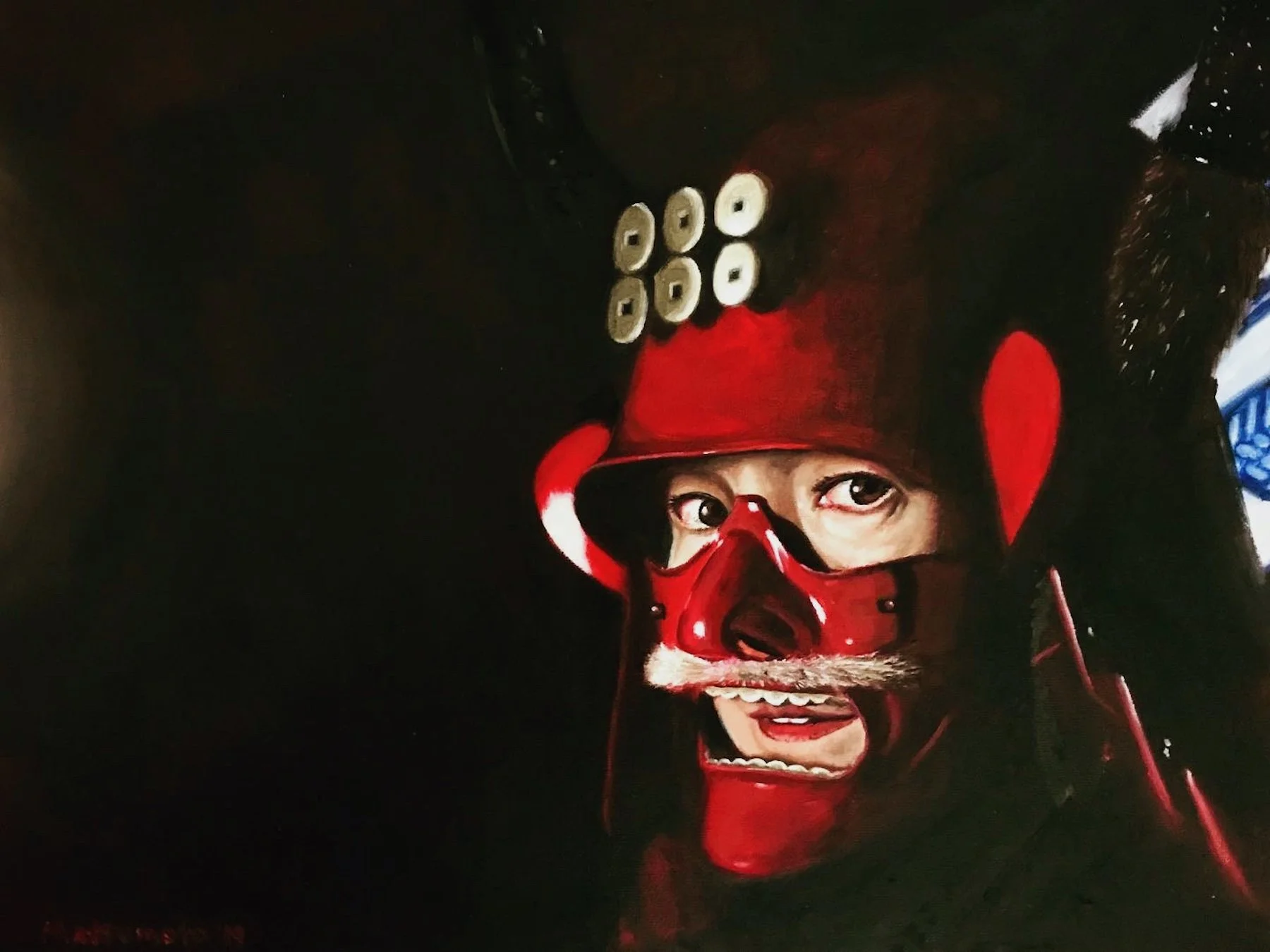Interview with Edi Matsumoto

“My artworks are a celebration of beauty, strength, wisdom, and life force. I hope you find the goddess and warrior within you and use your power to change the world around you with your love and courage.”
Tell us about how you decided to become an artist and why?
I showed my husband a sketch I did in a hotel in Paris many years ago, long before I met him. It was a sketch of a typical 5-story apartment building across the street from the hotel. I sketched it on the back of my trip itinerary out of boredom during the Easter weekend because everything, museums, parks, restaurants, theaters, etc.), was closed for the holiday, and I had nothing else to do. I was going to throw it away but my husband stopped me; he said it was an incredible piece of art and I should go to art school and, as it is said, the rest is history.
Edi Matsumoto, ‘White Tara’, oil on canvas
Edi Matsumoto, ‘Bugeisha’, oil on canvas
I took a few art courses at a local community college and was encouraged by a teacher to go further. I applied to the Academy of Art University in San Francisco and started online courses for "personal enrichment." I would take some introductory courses, but they told me I must be in the master's program because I already had a master's degree (in Science of Nursing). I agreed reluctantly, thinking I would be way behind other students who already had bachelor's in fine art and worked as professional artists. I took one class per semester because I worked full-time as a nurse practitioner in a clinic. I also wanted to pace myself so that I could keep up with other students. During the introductory drawing class, I was first happy with my passing grade.
Then when I worked on a drawing of a drapery, I had an a-ha moment about what it takes to draw well. It took me 7.5 years to receive my master's degree in Fine Arts. My graduate thesis "Lives in Our Hands", focused on the real-life depiction of healthcare professionals. and turned into my first solo show at a local gallery.
What influences you the most when you are in the process of creating new artwork?
I paint realistic figures and portraits, so it is essential to make them real but not necessarily photographic. I spend time looking at and comparing my painting with the model or the reference photograph. I paint relatively fast, but when the canvas is filled with colors, and the basic figures are done, things become interesting. I may paint the whole thing (the figures and background) as they appear in real life, or I may add a completely different element, which includes abstract and imaginary elements, until I am totally satisfied. I rely a lot on my intuition. It is as if I get inspiration from the universe and it gives me the final OK.
In that sense, the model is my initial inspiration, and the figure wants to speak on canvas. There are many occasions when I am done with the figures but keep experimenting with the background. For example, I changed the scene of Bugeisha at least three times until I got an OK from the universe.
How does your heritage influence your artwork?
I am Japanese-American, and I moved to the US 27 years ago. My Japanese aesthetics, of course, influence me a lot. It is awe-inspiring how aesthetics are embedded in Japanese culture, from flower arrangement, tea ceremony, kimono design, and architecture to wrapping papers, food presentation, and gardens. I particularly love the emphasis on subtlety (Wabi, Sabi), blank space, and balance in Japanese aesthetics. I get inspiration from my recent works from Ukiyo-e compositions and subject matter such as kimono-clad women and Ukiyoe background.
My family on my mother's side is very artistic. My great-grandfather was a traditional Japanese painter who painted flowers, birds with inkbrushes. My late sister was a professional cartoonist. My mother and uncle are very artistic and crafty, painting, sewing, creating leather bags and furniture. Drawing and painting were typical in our household, and that was probably partially why I did not think of becoming an artist until late in my life when my husband pointed out that I had talent.
Which artists are you most inspired by?
In retrospect, I appreciate my parents having the masterpiece book series of the most famous artists in the world. I grew up immersing myself in these masterpiece artworks when other kids were reading children's books. My parents had art series, a world travel series, and an essential science series - I was hungry for all the knowledge as well as beauty.
Among the masters, I specially enjoyed Monet. Manet, Degas, Renoir, Da Vince, Rafael, Turner, Whistler, and Modigliani. Since art school, the most inspirational artist has been Daniel Sprick. I always credit my local teachers, Brian Blood, for the landscape instructions and Warren Chang for portraits and figures. I have been lucky enough to take workshops from Robert Liberace, Max Ginsberg, and Scott Burdick when they come to the Monterey area.
Edi Matsumoto, ‘A Life in My hands’, oil on canvas
Edi Matsumoto in her studio.
How do you describe art as a healing tool?
There are many ways that art can be used as a healing tool. I have written articles about it and given a presentation on this topic. From the viewers' perspective, if they identify with the artwork, it aids the healing process. The subjects’ emotions may resonate with a viewer, as if they are going through the hero's journey together. A figure, motif, shapes, or colors can both heal and elevate the energy.
For example, my graduating thesis, "Lives in Our Hands," was a series to depict realistic healthcare professionals with all their glory and misery. I painted several healthcare professionals in distress because of the unbearable stress and anxiety the current healthcare system can impose upon them. Some people find solace in seeing it. Maybe it is like seeing Munch's Scream. When people identify themselves in the character of the painting, it can be healing.
I know that some of my commissioned works had a significant impact on people's lives.
For example, I had a prominent retired physician friend who knew that he did not have much time left before his terminal illness took his life. He asked me to paint his portrait and asked me to ship it to the office of a medical organization that he helped set up 50 years ago.
He was able to see the completion of the painting, and the original painting was hung exactly as he wished. His three children received a giclée copy of the image as well, and it was very healing to fulfill his last wish and leave his legacy for the medical profession and for his children.
In another portrait, I painted a couple. The husband passed away one year previously, and his wife, who was left behind, was inconsolable. I painted them based on a photograph from their happy days together. When she saw the painting, she was speechless. She had lunch with the painting in a chair next to her and talked to her husband with a gentle smile. Later, I made a pillow of the image and sent it to her. She was again speechless, and she was happy to be able to take the image with her and hug his image on the pillow.
Art also has an immediate effect on changing people's moods. I had a delivery man who tried to deliver a giant heart sculpture to my studio. There were stairs, and the doorway was narrow, and he was upset that it was not going to be an easy delivery. He walked into my studio and saw a painting I was working on, and immediately his mood changed. "Did you paint that?" and he became very pleasant and helpful from that moment on.
There are also huge elements of healing when people create art to express themselves. Painting is not always easy, but the inspirational, creative process is freeing and joyful. It sure serves as my stress-reliever when I have a tough time at the hospital.
Do you have a dream project? What might that be?
I want to continue with the theme of healing; my dream project is to create a series of paintings and turn them into a picture book that helps people shift consciousness when looking at it, like Escher, Dali, Magritte, and Da Vinci combined. I don't want to make it very serious or religious. My vision is to create a visual aid to shift from the narrow individual perspective that causes suffering to a broader universal perspective that lightens suffering and frees up the mind.
I can describe it as spiritual. I want to make it so that this can be a children's book and kids can grow up knowing how not to dwell on the negativity of the mind and be open to the limitless possibility available in the world to have a happy, fulfilled life.






